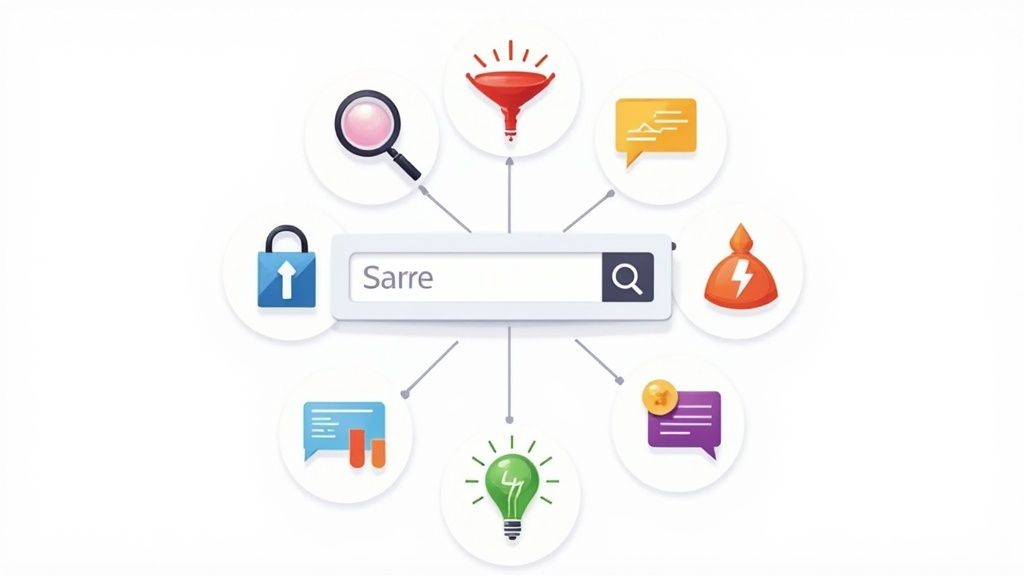
The Evolution of Multi-Channel Inventory Management

The retail world has changed dramatically. Businesses are no longer limited to a single sales channel. Customers now expect to find products easily across various platforms. This shift has created a critical need for effective multi-channel inventory management.
This involves tracking and managing stock levels across every sales channel. Think online marketplaces like Amazon and Shopify, physical stores, and even social commerce platforms.
Historically, single-channel selling was the standard. The rise of e-commerce and digital marketplaces, however, changed everything. Diversified sales channels became vital for business growth.
This expansion created new complexities in managing inventory across multiple touchpoints. Imagine a business selling on its website, through Amazon, and in a physical store. Each requires synchronized stock information to avoid overselling and keep customers happy.
Adapting to the Multi-Channel Reality
The need for a unified inventory approach is no longer just convenient; it's crucial for success. E-commerce continues to expand, and businesses selling across multiple channels see substantial revenue growth.
By 2022, businesses using multi-channel inventory management saw a 190% revenue increase compared to single-channel sellers. This highlights the value of accurate inventory tracking across platforms.
Effective systems prevent overselling and stockouts, improving customer satisfaction and operational efficiency. A McKinsey report also showed that poor inventory management can reduce profitability by up to 10%, emphasizing the need for strong multi-channel strategies. Find more statistics here: Learn more about Multi Channel Inventory Management.
This shift has changed business strategies. Retailers must now meet different customer expectations across channels. An Amazon shopper might want fast, free shipping, while a physical store customer values personalized service and the ability to experience the product firsthand. Adapting inventory management to meet these diverse needs is essential.
The Need for Centralized Inventory Control
Creating a unified inventory approach has its challenges. Maintaining consistency while adapting to each channel's unique requirements demands sophisticated systems and planning. This means integrating platforms, sometimes with different APIs and update frequencies.
It also requires accurate demand forecasting, even when customer behavior varies significantly between channels. The next section will explore the advantages of integrated inventory systems that address these complexities.
Transformative Benefits of Integrated Inventory Systems
Effective multi-channel inventory management offers significant strategic advantages for today's retailers, going far beyond simple stock tracking. Centralizing inventory creates a single source of truth, minimizing discrepancies and fostering customer trust. This eliminates the confusion and errors that can arise when juggling separate inventory data for each sales channel.
Streamlined Operations and Reduced Costs
One of the biggest benefits of an integrated system is the automation it provides. This automation reduces manual data entry, freeing up staff for more strategic tasks. For instance, automated reordering prevents stockouts and overselling, protecting your brand's reputation and ensuring a positive customer experience. This also reduces carrying costs by ensuring you don't have excess inventory sitting on shelves.
This automation also translates to significant cost savings. Imagine eliminating the need for manual stock checks and the tedious task of reconciling data between various systems. The time saved directly reduces labor costs and increases overall operational efficiency. Minimizing stockouts prevents lost sales, while reducing overstocking avoids tying up valuable capital in unsold merchandise.
Enhanced Customer Satisfaction and Brand Loyalty
Consistent stock availability across all channels contributes directly to customer satisfaction. When customers can easily find what they need, when they need it, they're much more likely to become repeat customers. This consistency builds brand loyalty and reinforces a positive brand image. In today's competitive market, this seamless experience is a key differentiator.
Moreover, multi-channel inventory management significantly reduces human error and centralizes data, leading to more accurate stock levels. Integrating automation into inventory management can boost order fulfillment accuracy by 25%. Advanced tracking technologies, like RFID, can help minimize shrinkage, which costs retailers an average of 1.6% of sales every year. This real-time visibility allows businesses to be responsive to market trends and evolving customer preferences. For a deeper dive into these statistics, Find more detailed statistics here.
Data-Driven Insights for Strategic Growth
Unified analytics from an integrated system offers unparalleled business intelligence. Imagine having clear visibility into which products perform best on each individual channel. This data empowers retailers to optimize inventory allocation, making sure that high-demand products are available where they sell best. This data-driven approach maximizes returns and reveals opportunities for growth.
By understanding which channels and products are most profitable, businesses can make informed decisions about product development, marketing campaigns, and overall business strategy. This level of granular insight is achievable only with a robust multi-channel inventory management system.
To illustrate the impact of multi-channel inventory systems across different business sizes, let's examine the following table:
Multi Channel Inventory Management Benefits by Business Size
This table represents potential improvements and may vary based on specific implementation and business context.
As demonstrated above, businesses of all sizes can gain substantial benefits from implementing a multi-channel inventory management system. Larger businesses, in particular, stand to gain the most in terms of time saved and revenue increase due to greater operational complexity. However, even smaller businesses can realize significant improvements in order accuracy and customer satisfaction, leading to a stronger bottom line.
Overcoming Critical Multi Channel Inventory Challenges

Managing inventory across multiple sales channels presents a unique set of obstacles. These challenges can significantly hinder growth and create operational headaches if not addressed strategically. This section explores some common pain points and offers actionable solutions for effective multi channel inventory management.
Synchronizing Data Across Disparate Systems
A major hurdle for many businesses is synchronizing inventory data across different systems. These systems often have mismatched APIs and varying update frequencies, making it difficult to maintain accurate inventory counts. Imagine trying to keep track of stock levels across your Shopify website, Amazon store, and physical retail location – each with its own separate system.
This disconnect can lead to discrepancies and inaccuracies. A sale on one platform might not be reflected immediately on another, creating the potential for overselling. A robust multi channel inventory management system is crucial for centralizing inventory data and automating updates across all platforms.
Accurate Demand Forecasting
Predicting demand is essential for successful inventory management. However, forecasting accurately across different channels, each with unique customer behaviors, can be a significant challenge. Customer preferences and buying patterns can differ drastically between online marketplaces and brick-and-mortar stores.
Sophisticated forecasting tools are invaluable in this context. These tools, often integrated within a multi channel inventory management system, can analyze historical sales data, seasonality, and current trends to predict future demand more precisely. This helps optimize stock levels and prevent stockouts or overstocking.
Integrating Legacy Systems
Many businesses grapple with the challenge of integrating older legacy systems with modern inventory management tools. This integration can be a complex and time-consuming process, often requiring significant technical expertise.
Despite the difficulties, integrating legacy systems is vital for maximizing the benefits of multi channel inventory management. Modern systems offer features like automated reordering, real-time tracking, and advanced analytics, features often absent in older systems. Adopting a phased integration approach can minimize disruptions and ensure a smoother transition.
Channel-Specific Inventory Rules
Different sales channels may necessitate distinct inventory rules and allocation strategies. You might, for example, allocate a specific percentage of inventory to your physical store while reserving a different portion for online sales. Managing these distinct strategies effectively can be difficult without a centralized system.
A robust multi channel inventory management solution allows for the creation of custom rules and automates inventory allocation based on predefined criteria. This ensures optimal stock distribution across all your sales channels.
Contingency Planning For Technology Failures
Technology, while powerful, is not infallible. Even the most advanced systems can experience outages or failures. Therefore, developing comprehensive contingency plans is critical for mitigating the impact of these inevitable disruptions.
These plans might involve backup systems, manual processes, or alternative fulfillment strategies. For instance, having a procedure in place to manually process orders if your online system fails can minimize disruption and maintain customer satisfaction. Solid contingency planning ensures business continuity even during unexpected technical issues.
Essential Features for Powerful Inventory Software

Picking the right inventory software can make or break your multi-channel strategy. With so many options available, it's important to look beyond the marketing hype and focus on the features that truly deliver.
Real-Time Synchronization: The Key to Multi-Channel Success
Real-time synchronization is the backbone of efficient multi-channel inventory management. It ensures that every transaction, whether it's a sale, return, or stock adjustment, is instantly updated across all your selling platforms. This prevents overselling, keeps inventory accurate, and builds customer trust. Imagine a customer buys a product on your Shopify store; your inventory on Amazon should adjust automatically. That's the power of real-time synchronization.
Smart Reordering: Balancing Supply and Demand
Smart reordering takes the guesswork out of inventory management. The software analyzes sales history, identifies trends, and even forecasts demand to automate the reordering process. This minimizes stockouts, maximizing sales potential, while also reducing the risk of overstocking and tying up capital. This is particularly helpful for businesses with seasonal sales fluctuations.
Channel-Specific Allocation Rules: Customized Control
Each sales channel has its own nuances and customer behaviors. Channel-specific allocation rules provide the flexibility to tailor inventory strategies for each platform. You can allocate more stock to your top-performing channel or reserve certain products for your physical store. This optimized distribution strategy maximizes sales across all your channels.
Actionable Analytics: Data-Driven Decisions
Raw data is useless without the tools to interpret it. Robust inventory software delivers actionable analytics that go beyond simple reports. It helps identify top-performing channels, products, and customer segments. This data empowers informed decisions about inventory allocation, marketing strategies, and overall business growth.
Seamless Integrations: Connecting Your Business
Inventory software shouldn't operate in a silo. Seamless integrations with your existing systems, including your eCommerce platform, shipping providers, and accounting software like Xero are essential. This streamlines data flow, reduces manual entry, and minimizes errors. Careful evaluation of integration capabilities is crucial for long-term success.
Scalability: Planning for Growth
As your business expands, your inventory management needs will change. Choose software that scales with you, accommodating increasing order volumes, new sales channels, and a growing product catalog. This avoids the disruption and expense of switching systems as your business evolves.
The following table summarizes the essential features discussed above across different tiers of inventory management solutions.
To help you understand the varying levels of functionality available, we've compiled a comparison table outlining essential features across different software tiers. This will help you choose the right solution based on your business size and complexity.
Essential Multi Channel Inventory Software Features ComparisonEvaluation of critical features across different tiers of inventory management solutions
This table highlights the increasing sophistication and complexity of features as you move from basic to enterprise solutions. While basic solutions offer essential functionalities, enterprise solutions provide advanced capabilities and require more complex implementation.
By prioritizing these key features, you'll be well-equipped to choose the right inventory software to empower your multi-channel strategy and fuel business growth. ECORN, with our deep understanding of Shopify and other eCommerce platforms, can help you navigate the selection and implementation process. Explore ECORN's eCommerce expertise.
Scaling Your Business Through Strategic Inventory Control
Smart inventory management is essential for sustainable business growth, especially for businesses selling on multiple platforms. It’s more than just knowing your stock levels; it's about strategic control to maximize efficiency and profit as your business expands.
Expanding Across Channels and Markets
Centralized inventory systems are crucial for managing the complexities of multi-channel selling. These systems provide a single, reliable view of your inventory data, simplifying expansion into new marketplaces and even international markets.
This centralized approach enables you to add sales channels without significantly increasing operational overhead. Imagine smoothly integrating a new online marketplace or opening a retail store without the hassle of separate inventory systems.
This efficient multi-channel inventory management system allows you to monitor stock, track orders, and manage fulfillment from a central hub. This simplifies operations, improves accuracy, and reduces error risks.
Leveraging Inventory Data for Growth
Inventory data holds valuable insights for identifying growth opportunities. Analyzing sales data across different channels can reveal top-performing products and their respective platforms.
This allows you to optimize product assortments by channel. This targeted approach ensures the right products are available on the right platforms, maximizing sales. For example, a popular online product might not perform as well in a physical store, and vice versa.
Data-driven insights also help anticipate demand fluctuations. Adding online marketplaces or physical stores increases inventory tracking complexity. Multi-channel systems address this with centralized dashboards for monitoring stock levels across all channels simultaneously. This centralized view is crucial for data-driven decisions. According to McKinsey, understanding customer buying patterns can help businesses anticipate demand, optimize stock, improve inventory turnover, and reduce costs associated with excess inventory. This allows companies to maintain a competitive edge. Learn more about multi-channel inventory management: Explore this topic further
Optimizing Fulfillment for Peak Seasons
Handling increased order volumes during peak seasons, like holidays or special promotions, presents a significant challenge. Maintaining customer satisfaction during these periods is critical for long-term success. Effective multi-channel inventory management involves strategies to ensure quick and accurate order fulfillment, even during high demand.
This could involve optimizing warehouse layouts, choosing strategic logistics partners, or implementing channel-specific fulfillment strategies. For instance, using different shipping carriers for online orders versus orders fulfilled from a physical store.
Channel-Specific Fulfillment Strategies
Developing channel-specific fulfillment strategies is essential for scaling your business. Each sales channel has unique requirements. For example, online marketplaces like Amazon often have strict fulfillment guidelines. Physical stores might offer in-store pickup or same-day delivery.
Tailoring fulfillment strategies to each channel improves efficiency and meets customer expectations. This also allows greater flexibility and control. ECORN, with its expertise in Shopify and other eCommerce platforms, can guide you in developing these tailored strategies. Discover ECORN's eCommerce expertise.
Implementing Multi-Channel Systems Without Disruption

Transitioning to multi-channel inventory management doesn't have to be a disruptive and overwhelming experience. A well-planned, phased approach can minimize disruption and pave the way for long-term success. This involves careful planning, meticulous data preparation, and a clearly defined implementation strategy.
Auditing, Cleaning, and Standardizing Before Migration
Before migrating to a new system, a comprehensive audit of your current inventory processes is essential. This audit helps pinpoint inefficiencies and highlight areas for improvement. Cleaning your existing data is equally critical. This involves correcting inaccuracies, eliminating duplicate entries, and ensuring data consistency across the board. Think of this process as a thorough spring cleaning for your inventory data.
A clean dataset is the foundation for a smooth transition and ensures reliable data within your new system. Establishing standardized SKU conventions is also vital. Consistent SKUs across all your sales channels simplify tracking and eliminate confusion. For instance, using a consistent prefix for products sold on Amazon can easily distinguish them from products sold on other platforms. This seemingly minor detail can significantly improve the accuracy and efficiency of your multi-channel inventory management.
Phased Implementation: A Step-by-Step Approach
A phased implementation is generally more effective than a large-scale, all-at-once launch. This measured approach allows for gradual adjustments and reduces the risk of overwhelming your team. Begin by integrating your highest-volume or most important sales channels first. This allows you to test and refine the system, resolving any unforeseen issues before expanding to other channels.
This controlled, manageable approach minimizes disruptions to your day-to-day operations. Prioritizing channels for integration requires careful evaluation. Factors such as sales volume, integration complexity, and strategic importance should all influence your decision-making process. For example, integrating your Shopify store before a smaller, less active marketplace might be a more strategic initial step.
Key Decisions for Seamless Integration
Several important decisions will influence the success of your system implementation. One of these is how to handle historical data migration. While it might be tempting to migrate all historical data, this can be a time-consuming and resource-intensive process. Focus on migrating the most relevant data, such as recent sales history and current stock levels.
Determining suitable buffer stock levels is another critical factor. This safety net provides a cushion against unexpected demand fluctuations or supply chain disruptions. Establishing clear reconciliation protocols is also essential to address any discrepancies between your inventory system and actual physical stock levels. Regular reconciliation ensures data accuracy and provides a clear picture of your inventory.
Training, Ownership, and Standard Operating Procedures
Successfully adopting a new system hinges on comprehensive training for your team. Provide clear instructions and accessible resources to ensure everyone understands how to use the new tools and processes effectively. Establishing clear ownership structures is also paramount.
Assign specific individuals or teams responsibility for managing different aspects of the inventory management system. This promotes accountability and prevents confusion. Finally, develop standardized operating procedures (SOPs) for all inventory-related tasks. SOPs ensure consistency and minimize errors. They also serve as valuable training resources for new team members.
Learn more about how ECORN can assist with your Multi Channel Inventory Management needs
The Future of Multi Channel Inventory Management
The world of multi-channel inventory management is constantly changing. New technologies offer exciting possibilities for optimizing inventory control, improving accuracy, and boosting efficiency across your sales channels. Let's explore some of the key trends shaping the future of inventory management.
AI and Machine Learning: Predictive Power
Artificial intelligence (AI) and machine learning (ML) are revolutionizing demand forecasting. These technologies analyze massive datasets – from historical sales data and market trends to even weather patterns – to predict future demand with remarkable accuracy. This helps businesses fine-tune stock levels, minimizing both stockouts and excess inventory. This predictive capability allows for more strategic inventory allocation across different channels, ensuring the right products are available at the right time and in the right place.
Omnichannel Fulfillment: Expanding Options
Leading retailers are increasingly embracing omnichannel fulfillment strategies. This includes options like ship-from-store, where online orders are fulfilled directly from a local retail store. These strategies demand robust inventory systems that provide real-time visibility into stock levels across all locations and optimize fulfillment based on current demand. Modern inventory systems are evolving to support these complex fulfillment models, offering increased flexibility and efficiency.
IoT, RFID, and Blockchain: Enhanced Visibility
Internet of Things (IoT) sensors, RFID technology, and blockchain are enhancing supply chain transparency. IoT sensors deliver real-time data on product location and condition. RFID tags allow for precise tracking of individual items throughout the supply chain. Blockchain technology creates a secure and transparent record of all transactions. Together, these technologies offer unprecedented visibility into the movement of goods, improving traceability and minimizing the risk of loss or theft.
Augmented Reality in Warehouse Operations
Augmented reality (AR) is finding practical applications in warehouse operations. AR overlays digital information onto the real-world environment, giving workers real-time guidance during picking and packing processes. This improves accuracy and efficiency within the warehouse, reducing errors and accelerating fulfillment. AR can direct workers to specific locations, provide step-by-step instructions for complex tasks, and even display product information directly on the items.
Strategic Adoption of Emerging Technologies
While these new technologies offer incredible potential, it's essential to adopt them strategically. Businesses should carefully consider which technologies best align with their unique business model and long-term objectives. Not every new technology is suitable for every business. It's crucial to focus on adopting technologies that provide measurable benefits rather than pursuing every new development. A thoughtful approach to technology adoption allows businesses to prepare for the future without investing in unnecessary complexity.









































































































